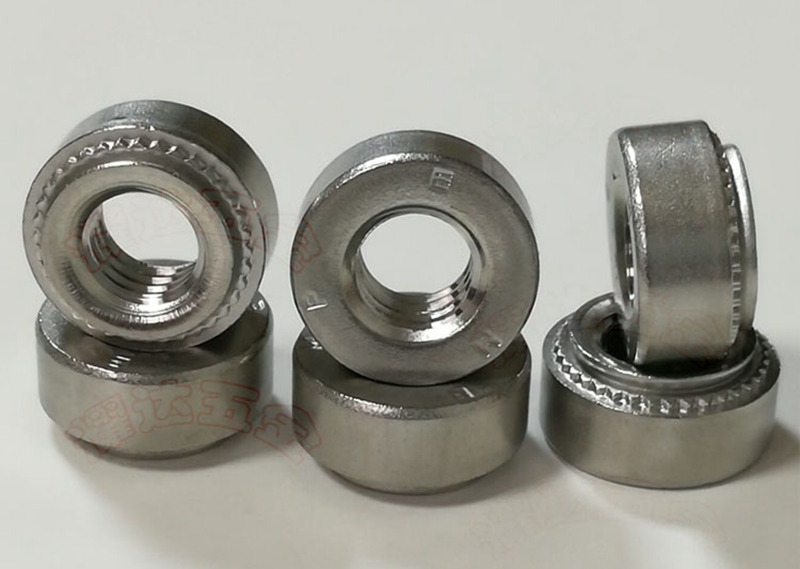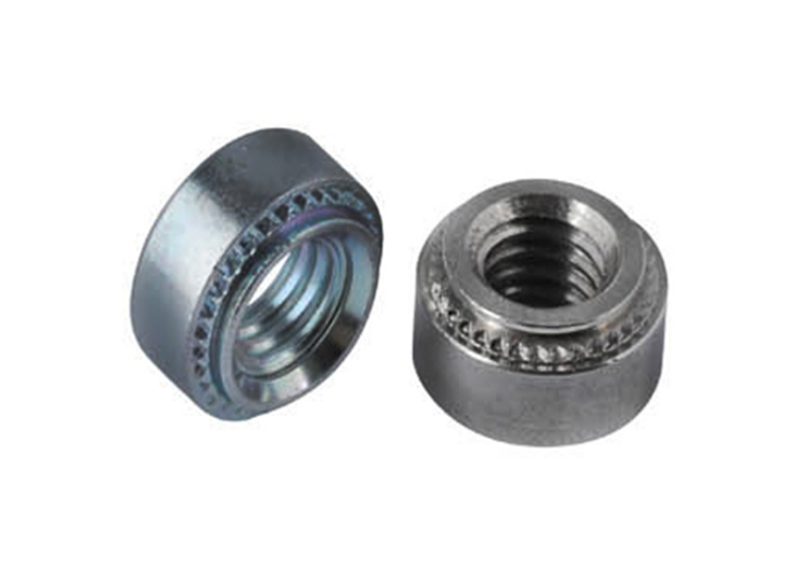The rivet nut and self-fastening nut are a kind of nut applied to a thin plate or a sheet metal, and have a circular shape with embossing teeth and a guiding groove at one end. The principle is that the embossed tooth is pressed into the preset hole position of the sheet metal. Generally, the aperture of the preset hole is slightly smaller than the embossed tooth of the rivet nut, and the pressure of the rivet nut is squeezed into the plate by pressure. The periphery of the hole is plastically deformed, and the deformed object is pushed into the guide groove, thereby producing a locking effect.
The rivet nut is divided into fast-cut steel rivet nut S type, stainless steel rivet nut CLS type, stainless steel rivet nut SP type and copper and aluminum rivet nut CLA type, which should be used in different environment. . Specifications are usually from M2 to M12. There is no uniform national standard for rivet nuts, which are often used in chassis cabinets and sheet metal industry.
Types:
S series, CLS series and SP series rivet nuts provide a simple method for installing internal thread to precision metal sheet products, which provides a reliable fixing function. The small and delicate nut makes the sheet flat and perfect. When installing, simply insert the nut into the hole of the metal plate to complete the setting function with pressure.
Application advantages:
1. The back of the sheet remains completely flat.
2, small and compact, suitable for all electronic or precision equipment.
3, high resistance to torque resistance.
4, the equipment is convenient, just simple pressing riveting.
5, the series of specifications, can meet a variety of design requirements.


Application Technical Guide:
1. S series rivet nuts adopt easy-cutting iron and are processed after heat treatment. CLS series rivet nuts are easy to use and easy to cut stainless steel, and the surface is not treated.
2. The hardness of low carbon steel plate must be less than 70RB, and the hardness of stainless steel plate must be less than 80RB.
3. Applicable to plates of various thicknesses, the minimum thickness is 0.8mm. The tail number Z corresponding to the A size must be determined according to the thickness of the plate and the nut specification. The user orders according to the thickness of the plate according to the tail number in the table;
4. According to the aperture size to be accurately controlled, according to the tolerance size of 0-+0.075mm, preferably punching, the nut should generally be installed from the "disconnect" surface of the board. The installation process is generally carried out by "pressing and riveting" work, and must not be knocked in.
Production Process:
The production process of the rivet nut and the production process of other screws are also roughly the same. Only the screw is punched out with a screw machine pier, and the nut is punched out with a nut machine pier. Introduce the production process of the rivet nut.
1. First of all, what kind of material is the rivet nut, what material is it, we can use what material to produce, what material to use for production. Knowing what materials and materials are used, we can buy screws and wires.
2. Determine the size and type of the rivet nut and see its size and length. This is how good it is to use the screw wire.
3. After determining what materials, materials, sizes and types, we need to see if it is a commonly used rivet nut. If it is, there must be a corresponding mold in the factory. If not, if it is non-standard, then we have to order the mold.
4. After all the production is ready, you have to use the nut machine pier to punch out the shape of the rivet nut, which is the appearance.
5. After the pier is punched out, use the machine that taps the nut to punch it.
6. After the thread is attacked, the plating process is carried out. The stainless steel rivet nut does not need to be plated, and only needs to be cleaned. To plate other colors, you have to go to a professional electroplating manufacturer for electroplating.
Electroplating
The rivet nut is generally used in the market for iron. Everyone knows that it is called carbon steel. The pier is punched out or turned out. It is made of natural color after being manufactured. In order to prevent rust, it is necessary. Electroplated. Stainless steel rivet nuts do not require plating. In the case of iron, the color of the plating is generally determined by the customer, and what kind of color is plated by the customer. There are also some requirements for salt spray time. Some electroplating color salt spray time is a little higher, some electroplating, less rust in a few hours. Another point is to see if customers need to export this product. Exports generally require environmental protection. Some domestic ones need it, but most of them are not needed.
The more electroplating used in the market for general rivet nuts is environmentally friendly blue zinc, because the salt spray test time of environmentally friendly blue zinc can reach 72 hours, that is, three days, this plating has a longer salt spray resistance time. In fact, for example, electroplating white nickel, white nickel salt spray time is relatively short, usually rusted in a few hours, less than 10 hours. However, some can be used to polish the electroplated white nickel, and the oil rivet nut can be used for a long time.

